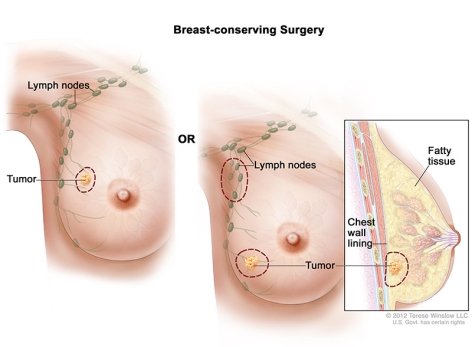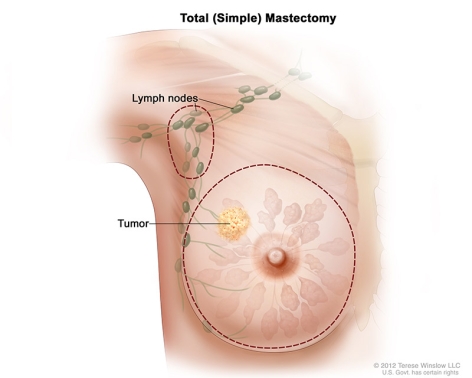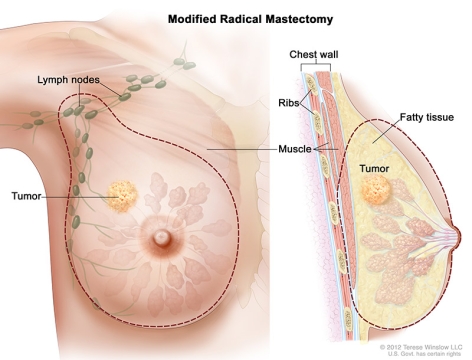Breast Cancer Treatment Options
Women diagnosed with breast cancer have many breast cancer treatment options available. Your breast cancer specialist and breast surgeon will review your specific case, including the stage, type, and hormone status of your cancer, and discuss the best plan for you. One or more of the following treatments may be recommended:
Chemotherapy for Breast Cancer
Chemotherapy uses drugs to kill cancer cells. The drugs that treat breast cancer are usually given through a vein (intravenous) or as a pill. You’ll probably receive a combination of drugs.
You may receive chemotherapy in an outpatient part of the hospital, at the doctor’s office, or at home. Some women need to stay in the hospital during treatment.
Some anticancer drugs can damage the ovaries. If you have not gone through menopause yet, you may have hot flashes and vaginal dryness. Your menstrual periods may no longer be regular or may stop. You may become infertile (unable to become pregnant). For women over the age of 35, this damage to the ovaries is likely to be permanent.
On the other hand, you may remain able to become pregnant during chemotherapy. Before treatment begins, you should talk with your doctor about birth control because many drugs given during the first trimester are known to cause birth defects.
Hormone Therapy for Breast Cancer
Hormone therapy may also be called anti-hormone treatment. If lab tests show that the tumor in your breast has hormone receptors, then hormone therapy may be an option. (See Lab Tests with Breast Tissue.) Hormone therapy keeps cancer cells from getting or using the natural hormones (estrogen and progesterone) they need to grow.
Hormone therapy options before menopause
Women who have not yet gone through menopause have a few hormone therapy options that include:
-
Tamoxifen: This drug can prevent the original breast cancer from returning and also helps prevent the development of new cancers in the other breast. As treatment for metastatic breast cancer, tamoxifen slows or stops the growth of cancer cells that are in the body. It’s a pill that you take every day for 5 years.
In general, the side effects of tamoxifen are similar to some of the symptoms of menopause. The most common are hot flashes and vaginal discharge. Others are irregular menstrual periods, thinning bones, headaches, fatigue, nausea, vomiting, vaginal dryness or itching, irritation of the skin around the vagina, and skin rash. Serious side effects are rare, but they include blood clots, strokes, uterine cancer, and cataracts. You may want to read the NCI fact sheet on Tamoxifen.
- LHRH agonist: This type of drug can prevent the ovaries from making estrogen. The estrogen level falls slowly. Examples are leuprolide and goserelin. This type of drug may be given by injection under the skin in the stomach area. Side effects include hot flashes, headaches, weight gain, thinning bones, and bone pain.
- Surgery to remove your ovaries: Until you go through menopause, your ovaries are your body’s main source of estrogen. When the surgeon removes your ovaries, this source of estrogen is also removed. (A woman who has gone through menopause wouldn’t benefit from this kind of surgery because her ovaries produce much less estrogen.) When the ovaries are removed, menopause occurs right away. The side effects are often more severe than those caused by natural menopause. Your healthcare team can suggest ways to cope with these side effects.
Hormone therapy options after menopause
Below are the hormone therapy options for women who have gone through menopause:
- Aromatase inhibitor: This type of drug prevents the body from making a form of estrogen (estradiol). Examples are anastrozole, exemestane, and letrozole. Common side effects include hot flashes, nausea, vomiting, and painful bones or joints. Serious side effects include thinning bones and an increase in cholesterol.
- Tamoxifen: Hormone therapy is given for at least 5 years. Women who have gone through menopause receive tamoxifen for 2 to 5 years. If tamoxifen is given for less than 5 years, then an aromatase inhibitor often is given to complete the 5 years. Some women have hormone therapy for more than 5 years. See above for more information about tamoxifen and its possible side effects.
Breast Cancer Targeted Therapy
Some women with breast cancer may receive drugs called targeted therapy. This type of treatment works differently than chemotherapy, killing only cancer cells and limiting damage to healthy ones. This often reduces the number of side effects you may experience.
Because not all tumors have the same targets, your doctor may run certain tests to identify the genes, proteins, and other factors specific to your tumor. This helps your breast cancer specialist determine the most effective treatment.
There are two main types of targeted therapy:
- Monoclonal antibodies, which block a specific target on the outside of cancer cells
- Small-molecule drugs, which block the process that helps cancer cells multiply and spread
Drugs used in targeted therapy have been developed to target specific cell changes. Therefore, the drugs given to patients are usually based on their specific hormone status and the type of breast cancer.
Targeted Therapy for HER2-Positive Breast Cancer
Tumors that have tested positive for a protein called human epidermal growth factor receptor 2 (HER2) are likely to grow and spread more aggressively. A variety of drugs have been developed that target this type of breast cancer, including:
-
Neratinib (Nerlynx): Nerlynx is an irreversible pan-HER inhibitor. Nerlynx works against HER2-positive breast cancer by blocking the cancer cells’ ability to receive growth signals.
-
Trastuzumab (Herceptin): Herceptin works against HER2-positive breast cancers by blocking the ability of the cancer cells to receive chemical signals that tell the cells to grow.
-
Pertuzumab (Perjeta): Like Herceptin, Perjeta works against HER2-positive breast cancers by blocking the cancer cells’ ability to receive growth signals.
-
Ado-trastuzumab emtansine or T-DM1 (Kadcyla): Kadcyla is a combination of Herceptin and the chemotherapy medicine emtansine. Kadcyla was designed to deliver emtansine to cancer cells in a targeted way by attaching emtansine to Herceptin. Herceptin then carries emtansine to the HER2-positive cancer cells.
-
Tykerb (Lapatinib): Tykerb works against HER2-positive breast cancers by blocking certain proteins that can cause uncontrolled cell growth.
Targeted Therapy for Hormone Receptor-Positive Breast Cancer
Hormone receptor-positive tumors typically begin with hormone therapy. To help make hormone therapy even more effective, certain targeted therapy drugs have been developed. These include:
-
Everolimus (Afinitor): Afinitor is an mTOR (mammalian target of rapamycin) inhibitor. Afinitor works against hormone-receptor-positive breast cancers that have stopped responding to aromatase inhibitors by stopping the cancer cells from getting the energy they need.
-
Bevacizumab (Avastin): Avastin works by blocking the growth of new blood vessels that cancer cells depend on to grow and function.
-
Palbociclib (Ibrance): Ibrance is a cyclin-dependent kinase 4/6 inhibitor. A kinase is a type of protein in the body that helps control cell division. Ibrance works by stopping cancer cells from dividing and growing.
-
Ribociclib (Kisqali): Kisqali is also a cyclin-dependent kinase 4/6 inhibitor like Ibrance. A kinase is a type of protein in the body that helps control cell division. Kisqali works by stopping cancer cells from dividing and growing.
-
Abemaciclib (Verzenio): Verzenio is a cyclin-dependent kinase 4/6 inhibitor, like Ibrance and Kisqali. A kinase is a type of protein in the body that helps control cell division. Verzenio works by stopping cancer cells from dividing and growing.
Targeted Therapy for Women with BRCA Gene Mutations
Women with hereditary breast cancer syndrome caused by inherited gene changes in BRCA1 and BRCA2 will receive a type of drug known as a PARP inhibitor. The primary drug used is:
-
Olaparib (Lynparza): Lynparza is a PARP inhibitor. The PARP enzyme fixes DNA damage in both healthy cells and cancer cells. Lynparza works against metastatic HER2-negative breast cancer with a BRCA1 or BRCA2 mutation by making it very difficult for these cancer cells to fix DNA damage.
Radiation Therapy for Breast Cancer
Radiation therapy (also called radiotherapy) uses high-energy rays to kill cancer cells. It affects cells only in the part of the body that is treated. Radiation therapy may be used after surgery to destroy breast cancer cells that remain in the area.
Doctors use two types of radiation therapy to treat breast cancer. Some women receive both types:
-
External radiation therapy: The radiation comes from a large machine outside the body. You will go to a hospital or clinic for treatment. Treatments are usually 5 days a week for 4 to 6 weeks. External radiation is the most common type used for breast cancer.
-
In some cases, hypofractionated radiation therapy treatments are used. This approach administers the same dose of radiation in a shorter time period. Instead of one short session every weekday for 6-8 weeks, it’s possible to increase the dose per day to shorten the number of weeks that radiation therapy is needed. Some patients complete radiation within 4-5 weeks when hypofractionated therapy is used.
-
-
Internal radiation therapy (implant radiation therapy or brachytherapy): The doctor places one or more thin tubes inside the breast through a tiny incision. A radioactive substance is loaded into the tube. The treatment session may last for a few minutes, and the substance is removed. When it’s removed, no radioactivity remains in your body. Internal radiation therapy may be repeated every day for a week.
Breast Cancer Immunotherapy
Immunotherapy for breast cancer involves the use of certain prescription medications to boost the immune system so that it can identify and destroy cancer cells more quickly and easily. Some types of breast cancer will respond to immunotherapy, which uses your own body’s immune system to slow or stop the growth of cancer cells. There is a protein on immune cells called “checkpoints” that can be turned on to attack cancer cells.
Breast cancer cells can disguise themselves as healthy cells, so the checkpoints on the cells don’t work correctly to attack the cancer. By using an immunotherapy drug called a checkpoint inhibitor, the immune system can more effectively play a role in tumor control.
Pembrolizumab (Keytruda) is a type of immunotherapy called an immune checkpoint inhibitor approved by the FDA to treat high-risk, early-stage, triple-negative breast cancer. It is used in combination with chemotherapy before surgery and then continued following surgery for 9 doses.
Breast Cancer Surgery
Surgery is the most common treatment for breast cancer. Your doctor can explain each type, discuss and compare the benefits and risks, and describe how each will change the way you look.
Breast-Sparing Surgery (Lumpectomy)
Lumpectomy is a breast-sparing surgery that removes the cancer but not the breast. This is an operation to remove the cancer but not the breast. The amount of tissue removed can vary greatly depending on the size of the tumor. The surgeon may also remove lymph nodes under the arm. Sometimes, an excisional biopsy is the only surgery a woman needs because the surgeon removed the whole lump.

Mastectomy
Mastectomy removes the entire breast (or as much of the breast tissue as possible). There are different types of mastectomy, which your breast cancer specialist will discuss with you.
-
In a total (simple) mastectomy, the surgeon removes the whole breast. Some lymph nodes under the arm may also be removed.

-
In modified radical mastectomy, the surgeon removes the whole breast, and most or all of the lymph nodes under the arm. Often, the lining over the chest muscles is removed. A small chest muscle also may be taken out to make it easier to remove the lymph nodes.

In some cases, a skin-sparing mastectomy may be an option. For this approach, the surgeon removes as little skin as possible.
Breast Cancer Reconstruction
You may or may not choose to have breast reconstruction. Breast reconstruction is plastic surgery to rebuild the shape of the breast. It may be done at the same time as the cancer surgery or later. If you’re considering breast reconstruction, you may wish to talk with a plastic surgeon before having cancer surgery.
Breast Cancer Doctors in Winchester, Virginia
The breast cancer specialists at Shenandoah Oncology are committed to providing comprehensive and compassionate care to our patients. We offer the latest in breast cancer treatments, including clinical trials for eligible patients close to home.
If you have been diagnosed with breast cancer, request an appointment with one of our breast cancer specialists today. We are located in Winchester, Virginia, and we see patients from the Shenandoah Valley, Northern Virginia, West Virginia, and Western Maryland.

 Learn More
Learn More